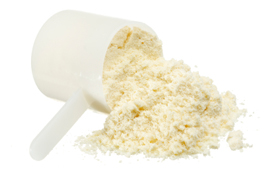Whey Protein-rich Diet Helps Reduce Fatty Liver Risks, Study Says

A study conducted by a team of researchers from the University of Lausanne found that a diet rich in whey protein can reduce the amount of fat in the liver.
Researchers from the University of Lausanne found out that the supplementation of whey protein in a person’s diet can lower the risk of developing fatty liver disease in obese women by reducing the amount of fat in liver cells. The study was published in an issue of Clinical Nutrition. They also found that whey protein was able to improve the study participants’ blood lipid profile which is important in promoting a healthier heart. The participants were asked to take the whey protein supplements for a period of four weeks.
Lead researcher Murielle Bortolotti said that their study was uncontrolled and preliminary but it strongly suggests that whey protein supplementation helps reduce the risk of fatty liver disease and promotes cardiovascular health as a long-term benefit. The researchers gathered a group of obese patients with an average BMI of 37.6 and IHCL concentrations between 1.9 to 20.5 percent. The participants were also recorded to have noticeable resistance to insulin with an average insulin sensitivity score of 2.77. The researchers observed that, after four weeks of whey protein supplementation, the study participants’ average IHCL dropped by 21 percent while their plasma triglyceride levels also went down by 15 percent. Their overall plasma cholesterol concentration was down by more than 7 percent after about a month of taking whey protein supplements. Researchers said that the result of the study indicates that whey protein has the potential to improve triglyceride profiles and IHCL.
The Liver and Fatty Liver Disease
The liver is the largest and heaviest glandular organ in the human body with an average weight of 1.36 kilograms. It is divided into four lobes which are unequal in size and shape. It is located at the right part of the abdominal cavity and just below the diaphragm. The portal vein and hepatic artery are responsible for carrying nutrients from the small intestines and oxygen-rich blood to the liver, respectively.
The human liver serves numerous functions including the production of enzymes that break down fats and produce glycogen from glucose. It is also responsible for producing urea and certain amino acids, storing of vitamins like vitamins B12, K, D, A and some minerals. The liver also produces 80 percent of the cholesterol in the body. The common disorders of the liver are liver cirrhosis, liver cancer, hepatitis and Wilson’s disease. The most harmful habit that affects the proper function of the liver is the excessive drinking of alcohol which can potentially alter the metabolic processes in the organ.
The root cause of fatty liver disease remains to be unknown. But medical experts are looking at patients’ resistance to insulin as the primary cause of the condition. Insulin resistance is a metabolic disorder where the cells are no longer responding properly to insulin in order to metabolize glucose.¬† In other words, insulin is no longer capable of performing its natural task of regulating sugar levels in the body. Nonalcoholic fatty liver disease is characterized by the accumulation of fat in the liver without the presence of alcohol. It refers to a wide spectrum of liver diseases from steatosis or simple fatty liver, cirrhosis or the irreversible and advanced scarring of the liver, to nonalcoholic steatohepatitis. Fatty liver disease is common throughout any age group; children can start developing fatty liver disease at the age of 10.
Natural Ways to Promote Liver Health
The liver is a very important organ in the body. Though minor health conditions concerning the liver are often very treatable, it is still necessary to keep the liver functioning properly to promote overall health.
- Diet plays a very important role in keeping the liver in tiptop shape. Ignoring hunger pangs or sudden and unscheduled eating can literally surprise the liver. Every time this happens, the liver exerts effort to produce the necessary enzymes to digest and metabolize the food properly. Eating at different hours of the day will overwork the liver and cause it to become exhausted. When struck with a sudden desire to eat, choosing foods that are not too heavy to the stomach like salads and fruits is recommended. And it is also a good way of maintaining a healthy body weight.
- Drinking plenty of water helps in washing away impurities and toxins out of the kidneys and liver. But drinking too much water while eating can interrupt the normal digestive process. So remember to observe proper pacing.
- The body has a limited requirement for sugars. Eating too much sweet foods can be dangerous to the liver and the human body. Sweets, especially those made or composed of refined sugar, will result to the excessive accumulation of fats in certain body parts like the buttocks, abdomen, thighs and the liver. Too much refined sugar will also result to the production of more triglycerides in the blood which, in turn, can increase the risk of developing cardiovascular disease. Some artificial sweeteners had been found by different studies to be poisonous to the body and result to fatigue and hypoglycemia. Eating fruits or blackstrap molasses when you want to eat something sweet are excellent alternatives to artificial sweeteners, especially for individuals with diabetes.
- Foods rich in protein like eggs, chicken, whole grains and legumes can help promote better liver health by helping it maintain a normal protein level in the body since the liver is responsible for producing protein. Low levels of protein can be a strong indication of kidney and liver disease. Eating natural and organic foods that are free of artificial sweeteners, colors, flavors and preservatives can also help in keeping the liver healthy.
- Some disease-causing bacteria can breed in the intestines. These organisms can cause permanent damage to the liver. So it is important to keep the intestines clean by drinking enough liquids and foods rich in dietary fiber.
- Eating less to lose weight can result to an insufficiency of nutrients supplied to the body. This makes the liver weak and incapable of producing enzymes that are needed in the proper digestion of food. Stop worrying too much about gaining weight and instead direct your attention to the foods that you eat to keep your liver and body healthy. As a reward, your liver will be able to better digest food and contribute in managing your weight.
Sources
nutraingredients.com
gicare.com
medicinenet.com
fitness.ygoy.com
Posted: February 15th, 2011 under Liver Health, Protein.
Tags: natural ways to reduce liver fat; health benefits of protein; natural ways to promote liver health
Comments: none

















